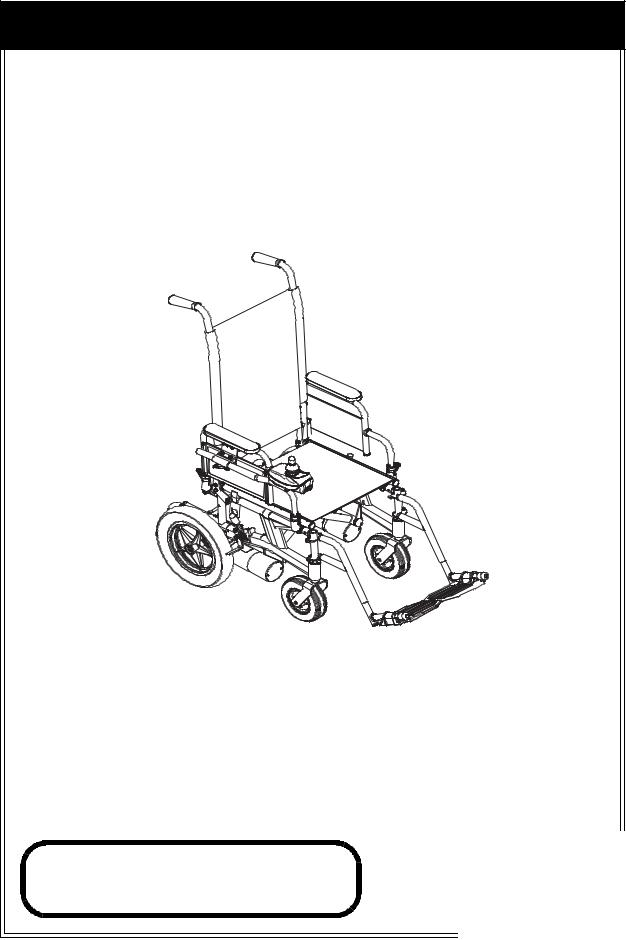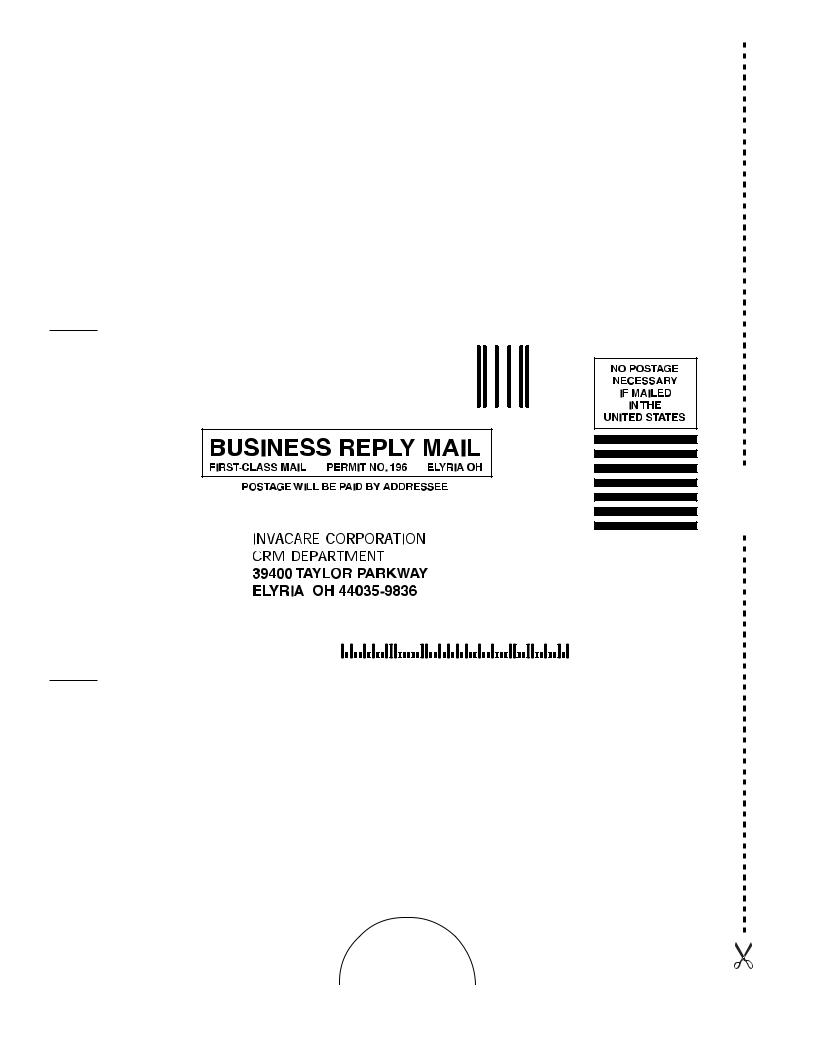Invacare R51LX, R51LXP, R51, R50LX User Manual

Owner’s Operator and Maintenance Manual
Nutron® Series
R50™LX, R51™,
R51LX, R51LXP
DEALER: This manual MUST be given to the user of the wheelchair.
USER: BEFORE using this wheelchair, read this manual and save for future reference.
For more information regarding Invacare products, parts, and services, please visit www.invacare.com

WARNING
A QUALIFIED TECHNICIAN MUST PERFORM THE INITIAL SET UP OF THIS WHEELCHAIR. ALSO, A QUALIFIED TECHNICIAN MUST PERFORM ALL PROCEDURES IN THE SERVICE MANUAL.
WHEELCHAIR USERS: DO NOT SERVICE OR OPERATE THIS EQUIPMENT WITHOUT FIRST READING AND UNDERSTANDING
(1) THE OWNER’S OPERATOR AND MAINTENANCE MANUAL AND (2) THE SEATING SYSTEM’S MANUAL (IF APPLICABLE). IF YOU ARE UNABLE TO UNDERSTAND THE WARNINGS, CAUTIONS, AND INSTRUCTIONS, CONTACT INVACARE TECHNICAL SUPPORT BEFORE ATTEMPTING TO SERVICE OR OPERATE THIS EQUIPMENT - OTHERWISE INJURY OR DAMAGE MAY RESULT.
DEALERS AND QUALIFIED TECHNICIANS: DO NOT SERVICE OR OPERATE THIS EQUIPMENT WITHOUT FIRST READING AND UNDERSTANDING (1) THE OWNER’S OPERATOR AND MAINTENANCE MANUAL, (2) THE SERVICE MANUAL (IF APPLICABLE) AND (3) THE SEATING SYSTEM’S MANUAL (IF APPLICABLE). IF YOU ARE UNABLE TO UNDERSTAND THE WARNINGS, CAUTIONS AND INSTRUCTIONS, CONTACT INVACARE TECHNICAL SUPPORT BEFORE ATTEMPTING TO SERVICE OR OPERATE THIS EQUIPMENT - OTHERWISE, INJURY OR DAMAGE MAY RESULT.
NOTE: Updated versions of this manual are available on www.invacare.com.
Nutron® Series |
2 |
Part No.1106645 |

TABLE OF CONTENTS |
|
TABLE OF CONTENTS |
|
REGISTER YOUR PRODUCT ............................................................... |
6 |
SPECIAL NOTES ................................................................................ |
9 |
TYPICAL PRODUCT PARAMETERS .................................................. |
10 |
SECTION 1—GENERAL GUIDELINES ................................................. |
11 |
Repair or Service Information ............................................................................................................... |
11 |
Operating Information............................................................................................................................. |
11 |
Tire Pressure ............................................................................................................................................. |
12 |
Electrical Accessories .............................................................................................................................. |
12 |
Grounding Instructions ........................................................................................................................... |
13 |
Batteries...................................................................................................................................................... |
13 |
Charging Batteries ............................................................................................................................... |
13 |
Rain Test..................................................................................................................................................... |
14 |
Weight Training ........................................................................................................................................ |
14 |
Weight Limitation..................................................................................................................................... |
14 |
SECTION 2—EMI INFORMATION ..................................................... |
15 |
SECTION 3—SAFETY/HANDLING OF WHEELCHAIRS ......................... |
17 |
Safety/Handling of Wheelchairs............................................................................................................. |
17 |
Stability and Balance................................................................................................................................. |
17 |
Coping With Everyday Obstacles......................................................................................................... |
17 |
A Note to Wheelchair Assistants.................................................................................................... |
18 |
Tilting........................................................................................................................................................... |
18 |
Tilting - Curbs....................................................................................................................................... |
18 |
Stairways..................................................................................................................................................... |
19 |
Escalators ............................................................................................................................................... |
20 |
Transferring To and From Other Seats .............................................................................................. |
20 |
Percentage of Weight Distribution ...................................................................................................... |
21 |
Reaching, Leaning and Bending - Forward .......................................................................................... |
21 |
Reaching and Bending - Backward........................................................................................................ |
22 |
SECTION 4—SAFETY INSPECTION/TROUBLESHOOTING .................... |
23 |
Safety Inspection Checklists................................................................................................................... |
23 |
Inspect/Adjust Initially ......................................................................................................................... |
23 |
Inspect/Adjust Weekly........................................................................................................................ |
24 |
Inspect/Adjust Monthly....................................................................................................................... |
24 |
Inspect/Adjust Periodically................................................................................................................. |
24 |
Troubleshooting Guide ........................................................................................................................... |
25 |
Checking Battery Charge Level............................................................................................................. |
26 |
Part No.1106645 |
3 |
Nutron® Series |

TABLE OF CONTENTS
TABLE OF CONTENTS |
|
SECTION 5—WHEELCHAIR OPERATION ........................................... |
27 |
Operating the Wheelchair...................................................................................................................... |
27 |
Turning the Power On/Off................................................................................................................ |
27 |
Using the Joystick to Drive the Chair............................................................................................. |
28 |
Using the Horn..................................................................................................................................... |
28 |
SPJ™Joystick Switches and Indicators ................................................................................................. |
29 |
Multi-Function Charger Port............................................................................................................. |
29 |
On/Off Toggle Switch ......................................................................................................................... |
29 |
Speed Control Knob ........................................................................................................................... |
29 |
Joystick.................................................................................................................................................... |
29 |
Information Gauge Display ................................................................................................................ |
29 |
SECTION 6—FRONT RIGGINGS ........................................................ |
31 |
Installing/Removing the Footrests......................................................................................................... |
31 |
Installing.................................................................................................................................................. |
31 |
Removing ............................................................................................................................................... |
31 |
Adjusting the Footrest Height............................................................................................................... |
32 |
Model PW93, PW93E, and PW93ST Footrests ........................................................................... |
32 |
Model 93M, 904A, PAL4A, and PAS4A Footrests ....................................................................... |
33 |
Replacing Heel Loops .............................................................................................................................. |
33 |
Installing/Removing Elevating Legrests................................................................................................. |
34 |
Installing.................................................................................................................................................. |
34 |
Removing ............................................................................................................................................... |
34 |
Raising/Lowering Elevating Legrests and/or Adjusting Calfpads .................................................... |
34 |
Raising/Lowering Elevating Legrests ................................................................................................ |
34 |
Adjusting Calfpads................................................................................................................................ |
35 |
Adjusting/Replacing Telescoping Front Rigging Support ................................................................. |
35 |
SECTION 7—ARMS ......................................................................... |
37 |
Adjusting Armrest Height....................................................................................................................... |
37 |
Using Swing-Back Arms........................................................................................................................... |
38 |
Replacing Desk/Full Length Armrest Pad and/or Clothing Guards (Fixed Height Arms Only) .
38
Armrest Pad .......................................................................................................................................... |
38 |
Clothing Guard..................................................................................................................................... |
38 |
Removing/Installing Armrest.................................................................................................................. |
39 |
Removing ............................................................................................................................................... |
39 |
Installing.................................................................................................................................................. |
39 |
SECTION 8—BACK ......................................................................... |
40 |
Adjusting the Back Height ...................................................................................................................... |
40 |
Using the Fold Down Back Canes (R51, 51LX and R51LXP Models Only)............................... |
41 |
Nutron® Series |
4 |
Part No.1106645 |

TABLE OF CONTENTS |
|
TABLE OF CONTENTS |
|
Changing the Back Angle ........................................................................................................................ |
41 |
SECTION 9—UPHOLSTERY/SEAT POSITIONING STRAP ..................... |
43 |
Replacing Seat Upholstery...................................................................................................................... |
43 |
Replacing Back Upholstery..................................................................................................................... |
43 |
Replacing Seat Positioning Strap ........................................................................................................... |
44 |
SECTION 10—JOYSTICK .................................................................. |
46 |
Preparing the Joystick For Use.............................................................................................................. |
46 |
Repositioning the Joystick....................................................................................................................... |
47 |
SECTION 11—CASTERS ................................................................... |
48 |
Adjusting Forks ......................................................................................................................................... |
48 |
SECTION 12—BATTERIES ................................................................ |
49 |
Warnings for Handling and Replacing Batteries................................................................................ |
49 |
Using the Proper Batteries..................................................................................................................... |
49 |
Recommended Battery Types ............................................................................................................... |
50 |
Installing/Removing the Battery Boxes ................................................................................................ |
51 |
Installing/Removing the Battery Tray................................................................................................... |
52 |
Installing/Removing the Batteries Into/From the Battery Boxes ................................................... |
53 |
Connecting Battery Cables .................................................................................................................... |
55 |
Direct Mount Method......................................................................................................................... |
55 |
Battery Clamp Method ....................................................................................................................... |
58 |
Replacing the Battery Box Retaining Strap......................................................................................... |
61 |
Cleaning Battery Terminals.................................................................................................................... |
62 |
Charging Batteries.................................................................................................................................... |
63 |
When To Charge Batteries ............................................................................................................... |
63 |
Description and Use of Battery Chargers...................................................................................... |
64 |
Connecting the Battery Charger...................................................................................................... |
64 |
SECTION 13—CLUTCH/MOTOR LOCK ............................................... |
65 |
Engaging/Disengaging the Clutches....................................................................................................... |
65 |
Disengaging/Engaging the Motor Lock Levers - R51LXP Only...................................................... |
66 |
Four Pole Motors................................................................................................................................. |
66 |
SECTION 14—WHEEL LOCKS ............................................................ |
67 |
Installing/Adjusting/Using the Wheel Locks ....................................................................................... |
67 |
Installing/Adjusting ............................................................................................................................... |
67 |
Using ....................................................................................................................................................... |
68 |
SECTION 15—ANTI-TIPPERS ........................................................... |
69 |
Part No.1106645 |
5 |
Nutron® Series |

TABLE OF CONTENTS
TABLE OF CONTENTS |
|
Installing/Removing the Anti-Tippers................................................................................................... |
69 |
Installing.................................................................................................................................................. |
69 |
Removing ............................................................................................................................................... |
69 |
SECTION 16—TRANSPORTING ........................................................ |
71 |
Transporting the Nutron........................................................................................................................ |
71 |
Unfolding/Folding the Wheelchair ................................................................................................... |
71 |
Unfolding .......................................................................................................................................... |
71 |
Folding ............................................................................................................................................... |
71 |
LIMITED WARRANTY ..................................................................... |
75 |
REGISTER YOUR PRODUCT |
|
The benefits of registering:
1.Safeguard your investment.
2.Ensure long term maintenance and servicing of your purchase.
3.Receive updates with product information, maintenance tips, and industry news.
4.Invacare can contact you or your provider, if servicing is needed on your product.
5.It will enable Invacare to improve product designs based on your input and needs.
Register ONLINE at www.invacare.com - or -
Complete and mail the form on the next page
Any registration information you submit will be used by Invacare Corporation only, and protected as required by applicable laws and regulations.
Nutron® Series |
6 |
Part No.1106645 |

Cut Along Line
PRODUCT REGISTRATION FORM
Register ONLINE at www.invacare.com - or -
Complete and mail this form
Name_______________________________________________________________ |
|
||||||
Address _____________________________________________________________ |
|
||||||
City ___________________State/Province __________ |
|
|
|||||
Zip/Postal Code ________ |
|
|
|
|
|
||
Email ___________________________________Phone No. _________________ |
Fold |
||||||
Invacare Model No. ______________________Serial No. __________________ |
here |
||||||
|
|||||||
Purchased From _________________________Date of Purchase:___________ |
|
||||||
|
|
|
|
|
|
||
1. |
Method of purchase: (check all that apply) |
|
|
|
|
||
Medicare |
Insurance |
Medicaid |
Other |
__________________________ |
|
||
2. |
This product was purchased for use by: (check one) |
|
|
|
|||
Self |
Parent |
Spouse |
Other |
|
|
|
|
3. |
Product was purchased for use at: |
|
|
|
|
||
Home |
Facility |
Other |
|
|
|
|
|
4. |
I purchased an Invacare product because: |
|
|
|
|
||
Price |
Features (list features) _________________________________________ |
|
|||||
5. |
Who referred you to Invacare products? (check all that apply) |
|
|
||||
Doctor |
Therapist Friend Relative Dealer/Provider |
Other_________ |
|
||||
Advertisement (circle one): TV, Radio, Magazine, Newspaper |
No Referral_____ |
|
|||||
6.What additional features, if any, would you like to see on this product?
__________________________________________________________________________ Fold
7. |
Would you like information sent to you about Invacare products that may be available for a here |
|
particular medical condition? Yes No |
|
If yes, please list any condition(s) here and we will send you information by email and/or mail about |
|
any available Invacare products that may help treat, care for or manage such condition(s): |
|
__________________________________________________________________________ |
8. |
Would you like to receive updated information via email or regular mail about the Invacare |
|
home medical products sold by Invacare's dealers? Yes No |
9.What would you like to see on the Invacare website?
__________________________________________________________________________
10.Would you like to be part of future online surveys for Invacare products? Yes No
11.User's Year of birth: ______________________________________________________
If at any time you wish not to receive future mailings from us, please contact us at Invacare Corporation, CRM Department, 39400 Taylor Parkway, Elyria, OH 44035, or fax to 877-619-7996 and we will remove you from our mailing list.
To find more information about our products, visit www.invacare.com.
Nutron® Series |
7 |
Part No.1106645 |

Fold here
 Cut Along Line
Cut Along Line
Fold here
Invacare Product Registration Form
Please Seal with
Tape Before Mailing
Part No.1106645 |
8 |
Nutron® Series |

SPECIAL NOTES
SPECIAL NOTES
WARNING/CAUTION notices as used in this manual apply to hazards or unsafe practices which could result in personal injury or property damage.
NOTICE
THE INFORMATION CONTAINED IN THIS DOCUMENT IS SUBJECT TO CHANGE WITHOUT NOTICE.
WHEELCHAIR USER
As a manufacturer of wheelchairs, Invacare endeavors to supply a wide variety of wheelchairs to meet many needs of the end user. However, final selection of the type of wheelchair to be used by an individual rests solely with the user and his/her healthcare professional capable of making such a selection.
WHEELCHAIR TIE-DOWN RESTRAINTS AND SEAT RESTRAINTS
Wheelchair users should NOT be transported in vehicles of any kind while in wheelchairs. As of this date, the Department of Transportation has not approved any tie-down systems for transportation of a user while in a wheelchair, in a moving vehicle of any type.
It is Invacare’s position that users of wheelchairs should be transferred into appropriate seating in vehicles for transportation and use be made of the restraints made available by the auto industry. Invacare cannot and does not recommend any wheelchair transportation systems.
Nutron® Series |
9 |
Part No.1106645 |

TYPICAL PRODUCT PARAMETERS
TYPICAL PRODUCT PARAMETERS
NUTRON R50LX, R51, R51LX, R51LXP
SEAT WIDTH RANGE |
14, 16, 18 or 20 inches |
|
|
SEAT DEPTH RANGE |
16, 17 or 18 inches (17 and 18 in. by extension) |
|
|
BACK HEIGHT RANGE STANDARD |
16, 17 or 18 inches |
|
|
SEAT-TO-FLOOR |
17¾ or 19¾ inches |
|
|
OVERALL WIDTH |
21¾ inches to 27¾ inches (With joystick) |
|
|
OVERALL HEIGHT |
|
LOW SEAT |
33¼ inches to 37¼ inches |
ADULT |
35¼ inches to 39¼ inches |
|
|
OVERALL LENGTH |
36½ inches to 47¼ inches |
|
|
WEIGHT |
|
W/O BATTERIES AND FRONT RIGGINGS |
82 pounds |
W/ BATTERIES AND PW93 FRONT RIGGINGS |
145 pounds |
UI GEL CELL (14-INCH CHAIRS) |
110 pounds |
22NF GEL CELL (16, 18 OR 20 INCH CHAIRS) |
157 pounds |
SHIPPING |
128 pounds |
|
|
DRIVE WHEELS/TIRES |
|
(FLAT FREE OR PNEUMATIC) |
12½ inches x 2¼ inches |
|
|
CASTERS W/PRECISION SEALED BEARINGS |
8 x 1¾ inches semi pneumatic (standard) |
|
8 x 2 inches pneumatic (optional) |
|
6 x 2 inches semi pneumatic (optional) |
|
|
ANTI-TIPPERS |
Rotating, removable (standard) |
|
|
FOOTREST/LEGREST |
Swingaway, removable |
|
|
ARMRESTS |
|
FIXED HEIGHT |
Desk and full length (standard) |
ADJUSTABLE HEIGHT |
Desk and full length (optional) |
|
|
UPHOLSTERY |
Black nylon |
|
|
BATTERIES |
UI gel cell |
BATTERY/SIZE (NOT SUPPLIED) |
22NF gel cell (not available on 14-inch wide wheel- |
TWO (2) REQUIRED |
chairs) |
|
|
SPEED (M.P.H.) |
0 to 4 (R50LX, R51, R51LX) or 0 to 6 (R51LXP) |
|
|
TURNING RADIUS |
35 inches |
|
|
*RANGE (VARIABLE) |
12 - 14 miles with UI batteries |
|
18 - 22 miles with 22NF batteries |
|
|
**WEIGHT LIMITATION |
|
R50LX, R51, R51LX |
250 lbs. |
R51LXP |
300 lbs. |
|
|
*NOTE: Range will vary with battery conditions, surface, terrain and operating weight.
**NOTE: Includes seating system and accessories.
Nutron® Series |
10 |
Part No.1106645 |

SECTION 1—GENERAL GUIDELINES
SECTION 1—GENERAL GUIDELINES
Repair or Service Information
Set up of the Electronic Control Unit is to be performed ONLY by individuals certified by Invacare. The final adjustments of the controller may affect other activities of the wheelchair. Damage to the equipment could occur under these circumstances. If non certified individuals perform any work on these units, the warranty is void.
Operating Information
Performance adjustments should only be made by professionals of the healthcare field or persons fully conversant with this process and the driverʹs capabilities. Incorrect settings could cause injury to the driver, bystanders, damage to the chair and to surrounding property.
After the wheelchair has been set up, check to make sure that the wheelchair performs to the specifications entered during the set up procedure. If the wheelchair does not perform to specifications, turn the wheelchair off immediately and re enter set up specifications. Repeat this procedure until the wheelchair performs to specifications.
DO NOT shift your weight or sitting position toward the direction you are reaching as the wheelchair may tip over.
DO determine and establish your particular safety limits by practicing bending, reaching and transferring activities in the presence of a qualified healthcare professional BEFORE attempting active use of the wheelchair.
DO NOT attempt to reach objects if you have to move forward in the seat.
DO NOT attempt to reach objects if you have to pick them up from the floor by reaching down between your knees.
DO NOT lean over the top of the back upholstery to reach objects from behind as this may cause the wheelchair to tip over.
DO NOT use an escalator to move a wheelchair between floors. Serious bodily injury may occur.
Before attempting to transfer in or out of the wheelchair, every precaution should be taken to reduce the gap distance. Turn both casters parallel to the object you are transferring onto. Also be certain the power is off and the wheel locks are engaged to prevent the wheels from moving.
DO NOT engage or disengage the motor release levers until the power is in the off position.
Invacare strongly recommends proceeding down ramps or slopes at half speed or slower and to avoid hard braking or sudden stops.
Nutron® Series |
11 |
Part No.1106645 |

SECTION 1—GENERAL GUIDELINES
DO NOT attempt to lift the wheelchair by lifting on any removable (detachable) parts. Lifting by means of any removable (detachable) parts of a wheelchair may result in injury to the user or damage to the wheelchair.
ALWAYS wear your seat positioning strap.
The seat positioning strap is a positioning belt only. It is not designed for use as a safety device withstanding high stress loads such as auto or aircraft safety belts. If signs of wear appear, belt MUST be replaced immediately.
Before performing any maintenance, adjustment or service verify that the ON/OFF switch on the joystick is in the off position.
Invacare products are specifically designed and manufactured for use in conjunction with Invacare accessories. Accessories designed by other manufacturers have not been tested by Invacare and are not recommended for use with Invacare products.
Avoid storage or use near external flame or combustible products.
DO NOT engage or disengage the motor locks/clutches until the power is in the OFF position.
DO NOT operate on roads, streets or highways.
DO NOT climb, go up or down ramps or traverse slopes greater than 9°.
DO NOT attempt to move up or down an incline with a water, ice or oil film.
DO NOT attempt to drive over curbs or obstacles. Doing so may cause your wheelchair to turn over and cause bodily harm or damage to the chair.
DO NOT leave the power button in the on position when entering or exiting your wheelchair.
DO NOT stand on the frame of the wheelchair.
DO NOT use the footplates as a platform. When getting in or out of the wheelchair, make sure that the footplates are in the upward position or swing footrests towards the outside of the chair.
Anti tippers MUST be used at all times. When outdoors on wet, soft ground or gravel surfaces, anti tippers may not provide the same level of protection against tipover. Extra caution must be observed when traversing such surfaces.
Tire Pressure
DO NOT use your wheelchair unless it has the proper tire pressure (p.s.i.). DO NOT overinflate the tires. Failure to follow these suggestions may cause the tire to explode and cause bodily harm. The recommended tire pressure is listed on the side wall of the tire.
Electrical Accessories
EXTREME care should be exercised when using oxygen in close proximity to electric circuits. Contact your oxygen supplier for instruction in the use of oxygen.
Part No.1106645 |
12 |
Nutron® Series |

SECTION 1—GENERAL GUIDELINES
Grounding Instructions
DO NOT, under any circumstances, cut or remove the round grounding prong from any plug used with or for Invacare products. Some devices are equipped with three prong (grounding) plugs for protection against possible shock hazards. Where a two prong wall receptacle is encountered, it is the personal responsibility and obligation of the customer to contact a qualified electrician and have the two prong receptacle replaced with a properly grounded three prong wall receptacle in accordance with the National Electrical Code. If you must use an extension cord, use only a three wire extension cord having the same or higher electrical rating as the device being connected. In addition, Invacare has placed RED/ORANGE WARNING TAGS on some equipment. DO NOT remove these tags.
Batteries
The warranty and performance specifications contained in this manual are based on the deep cycle gel cell batteries. Invacare strongly recommends their use as the power source for this unit.
Carefully read battery/battery charger information prior to installing, servicing or operating your wheelchair.
Charging Batteries
NEVER attempt to recharge the batteries by attaching cables directly to the battery terminals.
DO NOT attempt to recharge the batteries and operate the wheelchair at the same time.
DO NOT operate wheelchair with extension cord attached to the AC cable.
DO NOT attempt to recharge the batteries when the wheelchair has been exposed to any type of moisture.
DO NOT attempt to recharge the batteries when the wheelchair is outside.
DO NOT sit in the wheelchair while charging the batteries.
READ and CAREFULLY follow the manufacturer’s instructions for each charger (supplied or purchased). If charging instructions are not supplied, consult a qualified technician for proper procedures.
After charging batteries, ALWAYS make sure that the battery charger cord is unplugged. Failure to do this could result in damage to the cord or personal injury to the user or bystanders.
Use of improper extension cord could result in risk of fire and electric shock.
When using an extension cord, use only a three (3) wire extension cord having at least 16 AWG (American Wire Gauge) wire and the same or higher electrical rating as the device being connected. Use of improper extension cord could result in risk of fire and electric shock.
Nutron® Series |
13 |
Part No.1106645 |

SECTION 1—GENERAL GUIDELINES
Ensure the pins of the extension cord plug are the same number, size, and shape as those on the charger.
DO NOT under any circumstances cut or remove the round grounding plug from the charger AC cable plug or the extension cord plug.
Three (3) prong to two (2) prong adapters should not be used. Use of three (3) prong adapters can result in improper grounding and present a shock hazard to the user.
Rain Test
Invacare has tested its power wheelchairs in accordance with ISO 7176 Part 9 “Rain Test”. This provides the end user or his/her attendant sufficient time to remove his/her power wheelchair from a rain storm and retain wheelchair operation.
DO NOT leave power wheelchair in a rain storm of any kind.
DO NOT use power wheelchair in a shower or leave it in a damp bathroom while taking a shower.
DO NOT leave power wheelchair in a damp area for any length of time.
Direct exposure to rain or dampness will cause the chair to malfunction electrically and mechanically; may cause the chair to prematurely rust.
Check to ensure that the battery covers are secured in place, joystick boot is not torn or cracked where water can enter and that all electrical connections are secure at all times.
DO NOT use the joystick if the boot is torn or cracked. If the joystick boot becomes torn or cracked, replace immediately.
Weight Training
Invacare DOES NOT recommend the use of its wheelchairs as a weight training apparatus. Invacare wheelchairs have not been designed or tested as a seat for any kind of weight training. If occupant uses said wheelchair as a weight training apparatus, Invacare shall not be liable for bodily injury, and the warranty is void.
Weight Limitation
The Nutron R50LX, R51 and R51LX have a weight limitation, including the seating system, of 250 lbs. The Nutron R51LXP has a weight limitation of 300 lbs. Refer to Percentage of Weight Distribution on page 21.
Invacare recommends that only heavy duty wheelchairs be used for individuals weighing more than 250 lbs. Further, the activity level of the individual wheelchair user is important. For instance, a 170 lbs active wheelchair user could subject the wheelchair to more stress than a 250 lbs user. Invacare recommends that very active users consider using heavy duty wheelchairs.
Part No.1106645 |
14 |
Nutron® Series |

SECTION 2—EMI INFORMATION
SECTION 2—EMI INFORMATION
WARNING
CAUTION: IT IS VERY IMPORTANT THAT YOU READ THIS INFORMATION REGARDING THE POSSIBLE EFFECTS OF ELECTROMAGNETIC INTERFERENCE ON YOUR POWERED WHEELCHAIR.
Electromagnetic Interference (EMI) From Radio Wave Sources
Powered wheelchairs and motorized scooters (in this text, both will be referred to as powered wheelchairs) may be susceptible to electromagnetic interference (EMI), which is interfering electromagnetic energy (EM) emitted from sources such as radio stations, TV stations, amateur radio (HAM) transmitters, two way radios, and cellular phones. The interference (from radio wave sources) can cause the powered wheelchair to release its brakes, move by itself, or move in unintended directions. It can also permanently damage the powered wheelchair's control system. The intensity of the interfering EM energy can be measured in volts per meter (V/m). Each powered wheelchair can resist EMI up to a certain intensity. This is called its "immunity level." The higher the immunity level, the greater the protection. At this time, current technology is capable of achieving at least a 20 V/m immunity level, which would provide useful protection from the more common sources of radiated EMI.
There are a number of sources of relatively intense electromagnetic fields in the everyday environment. Some of these sources are obvious and easy to avoid. Others are not apparent and exposure is unavoidable. However, we believe that by following the warnings listed below, your risk to EMI will be minimized.
The sources of radiated EMI can be broadly classified into three types:
1)Hand-held Portable transceivers (transmitters-receivers with the antenna mounted directly on the transmitting unit. Examples include: citizens band (CB) radios, "walkie talkie", security, fire and police transceivers, cellular telephones, and other personal communication devices).
NOTE: Some cellular telephones and similar devices transmit signals while they are ON, even when not being used.
2)Medium-range mobile transceivers, such as those used in police cars, fire trucks, ambulances and taxis. These usually have the antenna mounted on the outside of the vehicle; and
3)Long-range transmitters and transceivers, such as commercial broadcast transmitters (radio and TV broadcast antenna towers) and amateur (HAM) radios.
NOTE: Other types of hand-held devices, such as cordless phones, laptop computers, AM/FM radios, TV sets, CD players, cassette players, and small appliances, such as electric shavers and hair dryers, so far as we know, are not likely to cause EMI problems to your powered wheelchair.
Nutron® Series |
15 |
Part No.1106645 |

SECTION 2—EMI INFORMATION
WARNING
Powered Wheelchair Electromagnetic Interference (EMI)
Because EM energy rapidly becomes more intense as one moves closer to the transmitting antenna (source), the EM fields from hand-held radio wave sources (transceivers) are of special concern. It is possible to unintentionally bring high levels of EM energy very close to the powered wheelchair's control system while using these devices. This can affect powered wheelchair movement and braking. Therefore, the warnings listed below are recommended to prevent possible interference with the control system of the powered wheelchair.
Electromagnetic interference (EMI) from sources such as radio and TV stations, amateur radio (HAM) transmitters, two-way radios, and cellular phones can affect powered wheelchairs and motorized scooters.
FOLLOWING THE WARNINGS LISTED BELOW SHOULD REDUCE THE CHANCE OF UNINTENDED BRAKE RELEASE OR POWERED WHEELCHAIR MOVEMENT WHICH COULD RESULT IN SERIOUS INJURY.
1)Do not operate hand-held transceivers (transmitters receivers), such as citizens band (CB) radios, or turn ON personal communication devices, such as cellular phones, while the powered wheelchair is turned ON;
2)Be aware of nearby transmitters, such as radio or TV stations, and try to avoid coming close to them;
3)If unintended movement or brake release occurs, turn the powered wheelchair OFF as soon as it is safe;
4)Be aware that adding accessories or components, or modifying the powered wheelchair, may make it more susceptible to EMI (NOTE: There is no easy way to evaluate their effect on the overall immunity of the powered wheelchair); and
5)Report all incidents of unintended movement or brake release to the powered wheelchair manufacturer, and note whether there is a source of EMI nearby.
Important Information
1)20 volts per meter (V/m) is a generally achievable and useful immunity level against EMI (as of May 1994) (the higher the level, the greater the protection);
2)The immunity level of the product is unknown.
Modification of any kind to the electronics of this wheelchair as manufactured by Invacare may adversely affect the RFI immunity levels.
Part No.1106645 |
16 |
Nutron® Series |

SECTION 3—SAFETY/HANDLING OF WHEELCHAIRS
SECTION 3—SAFETY/HANDLING OF WHEELCHAIRS
Safety/Handling of Wheelchairs
“Safety and Handling” of the wheelchair requires the close attention of the wheelchair user as well as the assistant. This manual points out the most common procedures and techniques involved in the safe operation and maintenance of the wheelchair. It is important to practice and master these safe techniques until you are comfortable in maneuvering around the frequently encountered architectural barriers.
Use this information only as a “basic” guide. The techniques that are discussed on the following pages have been used successfully by many.
Individual wheelchair users often develop skills to deal with daily living activities that may differ from those described in this manual. Invacare recognizes and encourages each individual to try what works best for him/her in overcoming architectural obstacles that they may encounter, however, ALL WARNINGS and CAUTIONS given in this manual MUST be followed. Techniques in this manual are a starting point for the new wheelchair user and assistant with “safety” as the most important consideration for all.
Stability and Balance
WARNING
ALWAYS wear your seat positioning strap.
The seat positioning strap is a positioning belt only. It is not designed for use as a safety device withstanding high stress loads such as auto or aircraft safety belts. If signs of wear appear, the belt must be replaced immediately.
To assure stability and proper operation of your wheelchair, you must at all times maintain proper balance. Your wheelchair has been designed to remain upright and stable during normal daily activities as long as you do not move beyond the center of gravity. DO NOT lean forward out of the wheelchair any further than the length of the armrests.
Coping With Everyday Obstacles
Coping with the irritation of everyday obstacles can be alleviated somewhat by learning how to manage your wheelchair. Keep in mind your center of gravity to maintain stability and balance.
Nutron® Series |
17 |
Part No.1106645 |

SECTION 3—SAFETY/HANDLING OF WHEELCHAIRS
A Note to Wheelchair Assistants
When assistance to the wheelchair user is required, remember to use good body mechanics. Keep your back straight and bend your knees whenever tilting wheelchair or traversing curbs, or other impediments.
WARNING
DO NOT attempt to lift the wheelchair by any removable (detachable) parts. Lifting by means of any removable (detachable) parts of a wheelchair may result in injury to the user or damage to the wheelchair.
Also, be aware of detachable parts such as arms or leg rests. These must NEVER be used for hand hold or lifting supports, as they may be inadvertently released, resulting in possible injury to the user and/or assistant(s).
When learning a new assistance technique, have an experienced assistant help you before attempting it alone.
Tilting
WARNING
DO NOT tilt the wheelchair without assistance.
When tilting the wheelchair, an assistant should grasp the back of the wheelchair on a non removable (non detachable) part. Inform the wheelchair occupant before tilting the wheelchair and remind him/her to lean back. Be sure the occupant’s feet and hands are clear of all wheels.
Tilting - Curbs
After mastering the techniques of tilting the wheelchair, use this procedure to tackle curbs, short stairs, etc.
This procedure requires two (2) assistants. The second assistant should be positioned at the front of the wheelchair lifting upward on a non removable (non detachable) part of the wheelchair frame when lifting the wheelchair and stabilizing the wheelchair when the wheelchair is being lowered to the ground.
The first assistant should turn the anti tippers so the wheels are pointing up, apply a continuous downward motion until the balance point is achieved and the front casters clear the curb. At this point, the assistants will feel a difference in the weight distribution.
Part No.1106645 |
18 |
Nutron® Series |

SECTION 3—SAFETY/HANDLING OF WHEELCHAIRS
WARNING
DO NOT let the wheelchair drop the last few inches to the ground. This could result in injury to the occupant.
Anti-tippers MUST BE used at all times. When outdoors on wet, soft ground or gravel surfaces, anti-tippers may not provide the same level of protection against tipover. Extra caution must be observed when traversing such surfaces.
Roll the wheelchair forward and SLOWLY lower the wheelchair in one continuous movement. Push the wheelchair forward until the rear wheels roll up and over the curb.
WARNING
Make sure anti-tipper wheels are pointing down towards the ground/floor before using the wheelchair.
Turn the anti tipper wheels down toward the ground/floor.
Stairways
WARNING
DO NOT attempt to move an occupied power wheelchair between floors using a stairway. Use an elevator to move an occupied power wheelchair between floors. If moving a power wheelchair between floors by means of a stairway, the occupant MUST be removed and transported independently of the power wheelchair.
Extreme caution is advised when it is necessary to move an unoccupied power wheelchair up or down the stairs. Invacare recommends using two (2) assistants and making thorough preparations. Make sure to use only secure, non-detachable parts for hand-hold supports.
DO NOT attempt to lift the wheelchair by any removable (detachable) parts. Lifting by means of any removable (detachable) parts of a wheelchair may result in injury to the user or damage to the wheelchair.
The weight of the wheelchair without the user and batteries is between 80 and 127 lbs. Use proper lifting techniques (lift with your legs) to avoid injury.
1.Remove the occupant from the wheelchair.
2.Remove the battery boxes from the wheelchair. Refer to Installing/Removing the Battery Boxes on page 51.
3.If necessary, fold the wheelchair. Refer to Transporting the Nutron on page 71.
4.Bend your knees and keep your back straight.
5.Using non removable (non detachable) parts of the wheelchair, lift the wheelchair off of the ground and transfer the wheelchair up or down the stairs.
Nutron® Series |
19 |
Part No.1106645 |

SECTION 3—SAFETY/HANDLING OF WHEELCHAIRS
6.The wheelchair should not be lowered until the last stair has been negotiated and the wheelchair has been carried away from the stairway.
Escalators
WARNING
DO NOT use an escalator to move a wheelchair between floors. Serious bodily injury may occur.
Transferring To and From Other Seats
WARNING
ALWAYS turn the wheelchair power OFF and engage the clutches to prevent the wheels from moving BEFORE attempting to transfer in or out of the wheelchair. Also make sure every precaution is taken to reduce the gap distance by turning both casters parallel to the object you are transferring onto.
CAUTION
When transferring, position yourself as far back as possible in the seat. This will prevent broken screws, damaged upholstery and the possibility of the wheelchair tipping forward.
NOTE: For this procedure, refer to FIGURE 3.1.
NOTE: This activity may be performed independently provided you have adequate mobility and upper body strength.
1.Position the wheelchair as close as possible along side the seat to which you are transferring, with the casters pointing parallel to it.
2.Engage clutches. Refer to Engaging/Disengaging the Clutches on page 65.
3.Shift body weight into seat with transfer.
During independent transfer, little or no seat platform will be beneath you. Use a transfer board if at all possible.
MINIMUM GAP DISTANCE
FIGURE 3.1 Transferring To and From
Other Seats
Part No.1106645 |
20 |
Nutron® Series |

SECTION 3—SAFETY/HANDLING OF WHEELCHAIRS
Percentage of Weight Distribution
WARNING
DO NOT attempt to reach objects if you have to move forward in the seat or pick them up from the floor by reaching down between your knees.
Proper positioning is essential for your safety. When reaching, leaning, bending or bending forward, it is important to use the casters as a tool to maintain stability and balance.
Many activities require the wheelchair user to reach, bend and transfer in and out of the wheelchair. These movements will cause a change to the normal balance, center of gravity, and weight distribution of the wheelchair. To determine and establish your particular safety limits, practice bending, reaching and transferring activities in several combinations in the presence of a qualified healthcare professional before attempting active use of the wheelchair.
Reaching, Leaning and Bending - Forward
NOTE: For this procedure, refer to FIGURE 3.2.
1.Position the front casters as far forward as possible.
2.Engage clutches and, if applicable, wheel locks*.
WARNING
DO NOT attempt to reach objects if you have to move forward in the seat or pick them up from the floor by reaching down between your knees.
*Wheel locks are an option. You may order the wheelchair with or without wheel locks. Transfer to and from the wheelchair in the presence of a qualified healthcare professional to determine individual safety limits. Invacare strongly recommends ordering the wheel locks as an additional safeguard for the wheelchair user.
FIGURE 3.2 Reaching, Leaning and
Bending - Forward
Nutron® Series |
21 |
Part No.1106645 |

SECTION 3—SAFETY/HANDLING OF WHEELCHAIRS
Reaching and Bending - Backward
WARNING
DO NOT lean over the top of the back upholstery. This will change your center of gravity and may cause you to tip over.
NOTE: For this procedure, refer to FIGURE 3.3.
1.Position wheelchair as close as possible to the desired object.
2.Point the front casters as far forward as possible to create the longest possible wheelbase.
3.Reach back only as far as your arm will extend without changing your sitting position.
FIGURE 3.3 Reaching and Bending - Backward
Part No.1106645 |
22 |
Nutron® Series |

SECTION 4—SAFETY INSPECTION/TROUBLESHOOTING
SECTION 4—SAFETY INSPECTION/TROUBLESHOOTING
NOTE: Every six (6) months or as necessary take your wheelchair to a qualified technician for a thorough inspection and servicing. Regular cleaning will reveal loose or worn parts and enhance the smooth operation of your wheelchair. To operate properly and safely, your wheelchair must be cared for just like any other vehicle. Routine maintenance will extend the life and efficiency of your wheelchair.
Safety Inspection Checklists
Initial adjustments should be made to suit your personal body structure needs and preference. Thereafter follow these maintenance procedures:
Inspect/Adjust Initially
Ensure wheelchair rolls straight (no excessive drag or pull to one side).
Ensure arms are secure but easy to release and adjustment levers engage properly.
Ensure adjustable height arms operate and lock securely.
Ensure arm pivot points are free of wear and looseness.
Inspect seat and back upholstery for rips or sagging.
Ensure armrest pads sit flush against arm tubes.
Ensure seat release latch is functional. Replace if necessary.
Ensure wheel mounting bolts are secure on drive wheels.
Ensure no excessive side movement or binding when drive wheels are lifted and spun when disengaged (freewheeling).
Ensure wheel/fork assembly has proper tension when caster is spun. Caster should come to a gradual stop.
CAUTION
As with any vehicle, wheels and tires should be checked periodically for cracks and wear and should be replaced as necessary.
Loosen/tighten caster locknut if wheel wobbles noticeably or binds to a stop.
Ensure all caster/wheel/fork/headtube fasteners are secure.
Inspect tires for flat spots and wear.
Clean upholstery and armrests.
Inspect/Adjust Weekly
Inspect tires for flat spots and wear.
Nutron® Series |
23 |
Part No.1106645 |
